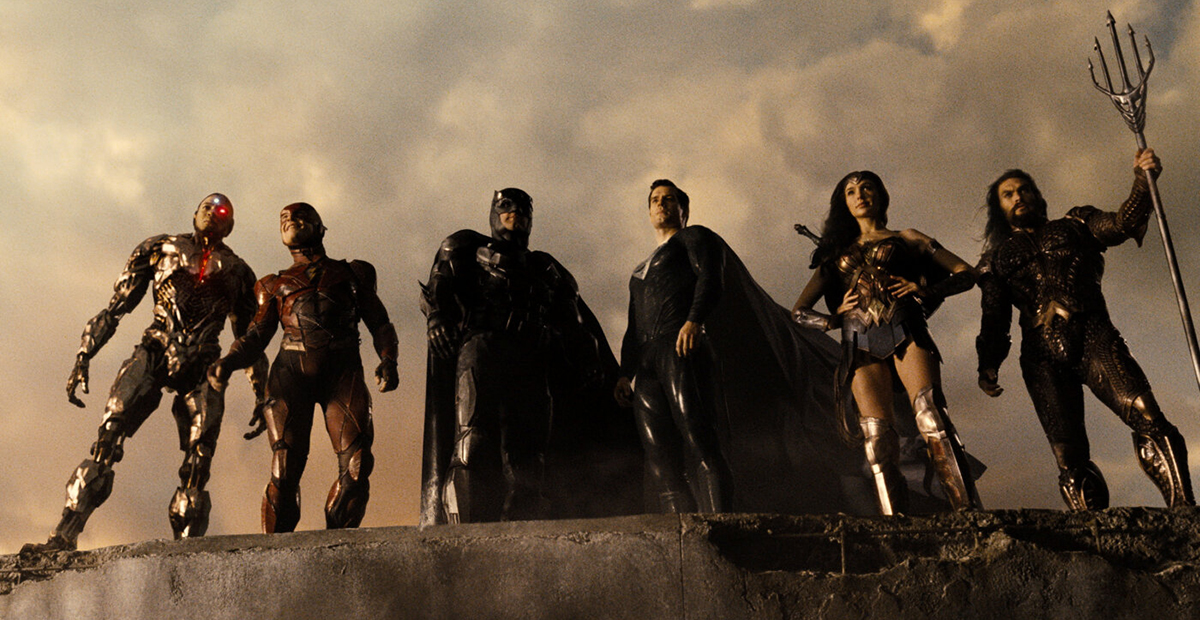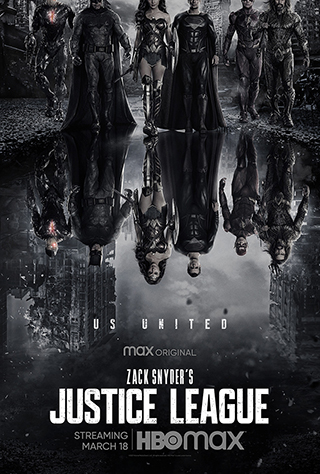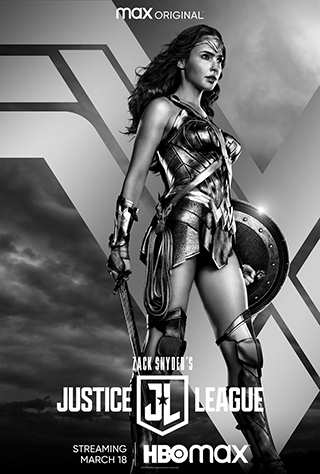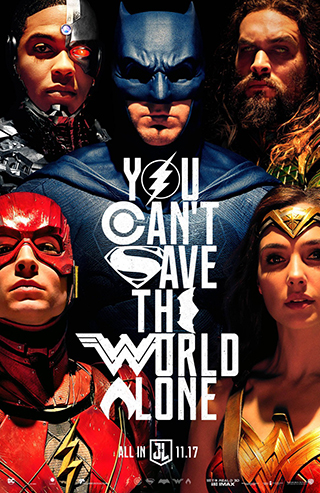Movies

New Releases • A-D • E-H • I-P • Q-Z • Articles • Festivals • Interviews • Dark Knight • Indiana Jones • MCU

There goes the sun
Photo: Warner Bros. Pictures / ™ & © DC Comics
Zack Snyder’s Justice League
Directed by Zack Snyder
Rated R
Reunited 18 March 2021
#ZackSnyderJusticeLeague • #SnyderCutJusticeLeague
Zack Snyder’s Justice League fixes the most egregious problems with the Joss Whedon cut, but it also introduces a fresh round of troubles.
Cut!
The best thing about this extended cut is it has a completely different conclusion that outshines the pathetic climax of the theatrical release. The Whedon cut featured an ending that was so lame, it was baffling (Whedon’s screenwriting credit has been removed from the Snyder cut). The new ending is better. However, it goes on and on as pieces are put in place for the series that was expected to follow. Sometimes less is more, but that’s hardly the lesson here.
It’s surprising how much from the theatrical version has been excised. Unfortunately, gone are the lighter elements Whedon brought, including a kinda cute opening of smartphone footage capturing Superman talking to a couple kids. This is now fully Snyder’s “O woe is the world” view of superherodom. Personalities, humor and sunshine, ye be banished from here. Somewhere between the two versions there’s a Super-Duper Extra-Deluxe Cut that offers a little more balance.
Zack Snyder’s Justice League certainly serves as a legitimate alternative to the MCU. The fact it even exists is something of a marvel in its own right (and pardon that allusion). Buoyed by fan outcries after Whedon butchered Justice League (the endgame of Snyder having to leave the movie after a personal family tragedy), Snyder was given $70 million to go back and finish the movie as he originally envisioned it. (That pushes the overall production budget to something on the order of $320 million, with the original release earning a relatively paltry $658 million at the global box office.) The result — and it’s not all that cynical of an observation — is available exclusively on the recently launched HBO Max (which rolls under the parent company of WarnerMedia) in order to pump up subscriber interest.

It’s a different headspace. It’s R-rated and clearly not aiming at mass appeal. As a single standalone movie, though, it tries to do too much. Hence its unwieldy four-hour run time that never would’ve flown as a theatrical experience (fully twice as long as the 2017 cut). That’s part of the beauty of the MCU’s approach. Characters have been introduced via standalone movies over the course of 12 years; Justice League throws in major new characters — Flash and Cyborg among them — without giving them the space they need to grow their appeal.
Much of what ailed the Whedon cut still ails the Snyder edition. Ben Affleck’s Bruce Wayne is still in a tug-of-war with George Clooney’s for the bottom rung. Jesse Eisenberg is still a poor choice for Lex Luthor. The romance between Superman and Lois Lane is still every bit as cold as pre-explosion Krypton.
It all starts with this bit of fan service, a title card before the movie begins: “This film is presented in a 4:3 format to preserve the integrity of Zack Snyder’s creative vision.” That 4:3 aspect ratio is intended to retain the presentation of the IMAX format. And that vision brings back Tom Holkenborg’s score — which was replaced by Danny Elfman in the theatrical cut. It’s nearly wall-to-wall music that ends with a pretentious addition: Allison Crowe covering Leonard Cohen’s Hallelujah over the end credits. Eyes roll along with the credits.
So, apparently, back in 2017 Warner Bros. didn’t care to preserve Snyder’s creative vision in virtually every sense possible. And the statement is rather disingenuous in itself. In conjunction with this Snyder cut, Batman v Superman has been rereleased on digital with enhanced color and the 4:3 aspect ratio restored, but that version is not available on HBO Max. Ostensibly, the preservation of integrity has its limits in the otherwise limitless world of streaming.
Lights!
In 2006, Zack Snyder pioneered a certain style of filmmaking with 300. It was as if movies and graphic novels got together and had a baby, one with such an over-achieving macho mindset it bordered on the Pythonesque level of self-parody.
The problem is that style of filmmaking has its boundaries. Ultimately, it becomes less of a filmmaking exercise and transforms into something more akin to motion comics. Here’s the bottom line: Snyder’s cut includes a remarkably small amount of natural light and an overabundance of CGI sets and landscapes, an element which becomes grating over the course of 240 minutes. Even in the handful of scenes filmed on location and not overrun by CGI in post-production, the sky tends to be overcast.
The end effect is like watching somebody else play a video game for four hours. A sense of the tactile, a grounding in some level of reality, is all but gone. How will this movie hold up 50 years from now? It might very well be dismissed the way some pass by the groundbreaking efforts of Ray Harryhausen; but he put the effects in their place, in service to the story. To make the impossible seem possible.
The artifice of Justice League doesn’t even attempt to capture a sense of photorealism; much of the CGI looks like a video game interstitial. It gets tiresome and it’s a problem that’s not limited to Snyder’s approach. So much of Justice League (pick your cut) — by way of both look and story elements — feels like Marvel’s Avengers: Infinity War. Arguably, that’s the second worst of the current 23 MCU theatrical entries, behind only The Incredible Hulk (2008). Infinity War didn’t even feel like a movie, there was so much CGI, such lack of humanity and such a fixation on technology. But the Russo brothers brought that same sense of over-engineered artifice to their latest effort, Cherry. It’s a much smaller movie about a drug-addled army vet who robs banks to pay for his habit. But the heart and heartache were buried under distracting film technique.
Snyder is — at the very core — all technique. If Justice League dialed it down on the CGI and brought a focus back on humanity — a reason to care, a sense of gravitas — there’d be a compelling movie on the screen. As it stands, after making it through this somber extended exercise, there’s an overwhelming desire to go outside and hug a tree. To bask in some sunshine. To feel... anything.
Action!
One of the then-perceived positive aspects of the theatrical Justice League was it felt a little breezier and more energetic than Snyder’s typical slogs (such as Watchmen and Batman v. Superman — which also received extended cuts on home video). There was reason to be cautiously optimistic the DC cinematic universe had turned the corner and was going to be fun again — something further borne out with Wonder Woman’s standalone features.

All of the promotional posters for the HBO Max release are in black-and-white
But, alas, Snyder’s brought back the gloom, the doom, the somber and sucked the fun right back out with this edition that includes a few unnecessary “F” bombs amid the burdensomely dark tone that sets this one’s target audience at the most patient and dedicated of basement dwellers. The pacing is sluggish; the sense of excitement is stifled, even when set against the incessant drum beats of Holkenborg’s score.
The fact this cut breaks the story out into six chapters — each given a title — and a 20-minute epilogue (also with a title) makes it clear Snyder is still obsessed with the graphic novel experience. It’s all about creating celluloid frames that recreate comic book frames. For all the effort, for all the money and for all the creative power both in front of and behind the camera, it’s jarring the end result engenders the same limited and superficial emotional and intellectual sensations as the old Hanna-Barbera Super Friends cartoons. It’s an odd miscarriage of filmmaking.
At one point, Wonder Woman rescues a group of schoolgirls on a class tour. A girl stares up at her in astonishment and asks, “Can I be like you some day?” Wonder Woman tells the girl, “You can be anything you want to be.” It’s a great response — and it’s not in the theatrical cut.
That’s where the story’s focus could’ve — and should’ve — been. Even as Diana Prince and Bruce Wayne corral others to join their league, a powerful theme could’ve hung on that line. Do you, girl. Do you, dude. And make the world a better place while you’re at it. That’d make for a timely and appealing hook. Like so many other elements here, it becomes merely another melancholy refrain in this dirge, even as the genesis of Cyborg and the Flash tries to provide some sort of hazy uplift.
Instead, it’s all about the dark side, led by Darkseid, Steppenwolf, Lex and the tease of other super villains. Plenty of dark, but so little light.
Epilogue!
Zack Snyder’s Justice League isn’t that much of a better movie, it’s mostly simply more movie. A lot more. And it all feeds off an unfortunate series of events and creative differences that led to the 2017 release.
The original intent, back before Snyder had to walk away in 2017, was probably something like this: release a 150-minute cut in theatres and — as is the modus operandi of Snyder — release an extended cut on home video. Most likely several months after the theatrical release makes it’s home debut in order to keep the revenue stream flowing.
That approximates the amount of value-added material in Snyder’s cut compared to the 2017 release. Somewhere around 30 minutes — and that’s being extremely generous. But, given the story structure, cutting it down to a sensible core likely led to the silly bookending of the “fear” angle.
Gone is the opening rooftop sequence with Batman and the early establishment of the evil forces that smell fear. Added in, though, are several unnecessary and overlong sequences in Themyscira and a lengthy back story involving Amazonians and Atlanteans battling Steppenwolf. Some of it feels like lost footage from 300.
Most of the footage added back in doesn’t drive the narrative. Some of it adds to the mood (okay, the sea shanty sung in honor of Aquaman (Jason Momoa, Conan the Barbarian) is pretty cool; the villagers worship the guy). But pretty much any new scene with Lois Lane (Amy Adams, Big Eyes) is trivial; there’s no need to see Lois order a couple cappuccinos for her police friends. That particular scene feels more like a Twin Peaks moment.
Thinking about that opening Batman sequence in the Whedon cut, thoughts drift to the prospect of a standalone Affleck Batman movie. What would something like that look like? Given even the relationshp between Bruce and Alfred (Jeremy Irons, Dead Ringers) is unappealing, it most likely wouldn’t work. Indeed, the next standalone Batman will star Robert Pattinson (Tenet) in a fresh spin on the character. But that’s a huge part of the problem DC has created here. A relatively unpopular Batman that is paired with an equally underwhelming Superman (Henry Cavill, The Man from U.N.C.L.E.).
It’s a case of having the two headliners propped up by other acts. Wonder Woman and Aquaman have launched successful spin-offs. The Flash has been going through development heck and is now set to include — holy casting, Batman! — both Michael Keaton and Ben Affleck as the Caped Crusader. Unfortunately for Ray Fisher, his claims of a toxic environment during the Whedon reshoots have reportedly created fresh tensions and led to Cyborg being downplayed in future DC projects. For that matter, Cavill’s future with the franchise has also been grist for the rumor mill.
While the Snyder cut has created some buzz for HBO Max, it hasn’t done a thing to solve the problems facing the DC cinematic universe. In some respects, it’s only amplified the tonal dissonance. To that end, the reality for DC is still every bit as dark as Snyder’s movie.
• This is the Extended Ultimate Edit review. The original review was published at MovieHabit.com.



